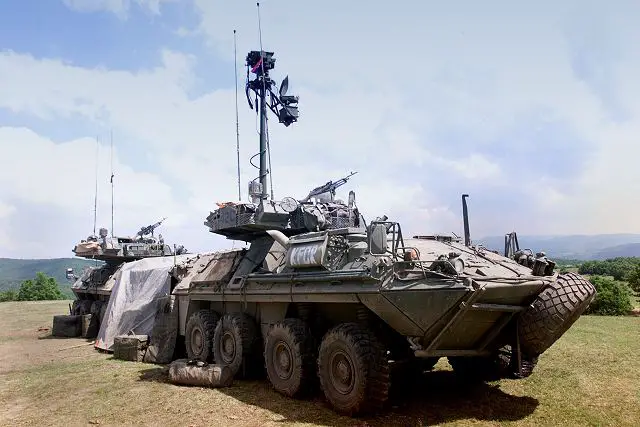| a | |||
Defense News - Canada |
|||
| |
|||
| Thursday, August 16, 2012, 12:14 AM | |||
| Canadian Army wants to purchase a new Light Armoured Reconnaissance vehicle. | |||
The
Canadian Army hopes to have in place by the end of this year an initial
contract for a new vehicle-mounted surveillance system that can feed its
data into command-and-control networks.The Army uses the Coyote reconnaissance
vehicle, but its systems cannot transmit information to headquarters.
The Coyote was delivered in 1997, and its main drawback is that the data
it collects is stored on 8mm cassettes, which are then hand-delivered
to senior officers. (Source DefenseNews) |
|||
 Soldiers of The Royal Canadian Dragoons use the surveillance equipment in their Coyote reconnaissance vehicles to overlook the Serbian border town of Preöovo from high ground in the American sector of Kosovo. (Credit photo Combat Camera Canada) |
|||
The project consists
of replacing Coyote with the Light Armoured Vehicle-Reconnaissance:
Surveillance Systems Upgrade Project, known as LRSS UP. The Canadian
government has not released details on what the project will cost. But
industry representatives estimate the LRRS UP will be worth about 250
million Canadian dollars ($240 million). The vehicle’s surveillance sensors also cannot be operated if the Coyote is moving, Lozanski pointed out. Low to medium winds can cause the vehicle’s surveillance mast, erected while stationary, to sway, and the imagery being collected can become unstable. The surveillance system takes 20 to 40 minutes to set up and tear down — too much time in a combat situation, Army officers said. In addition, the Coyote chassis does not provide sufficient protection against improvised bombs, so the vehicles have played a limited role during the war in Afghanistan, Lozanski noted in his presentation. Troops are required to dismount from the vehicle to set up the surveillance system, putting them at risk. LRSS UP will acquire a system that produces digital information that can be fed into Canadian Forces networks. The detection range and identification capabilities of surveillance systems will be improved. The time to set up the system will be decreased, and the new vehicles will be able to transmit data while on the move. The operator control station will be designed so it can accept the future integration of data from unmanned aircraft and ground systems, industry representatives have been told. According to the LRSS UP letter of interest provided to industry, the surveillance suite will consist of day and night surveillance systems, a near-infrared illuminator, a GPS receiver and other range detection equipment. |
|||
Canadian Army wants to purchase a new Light Armoured Reconnaissance vehicle 1608123
- Posted On














